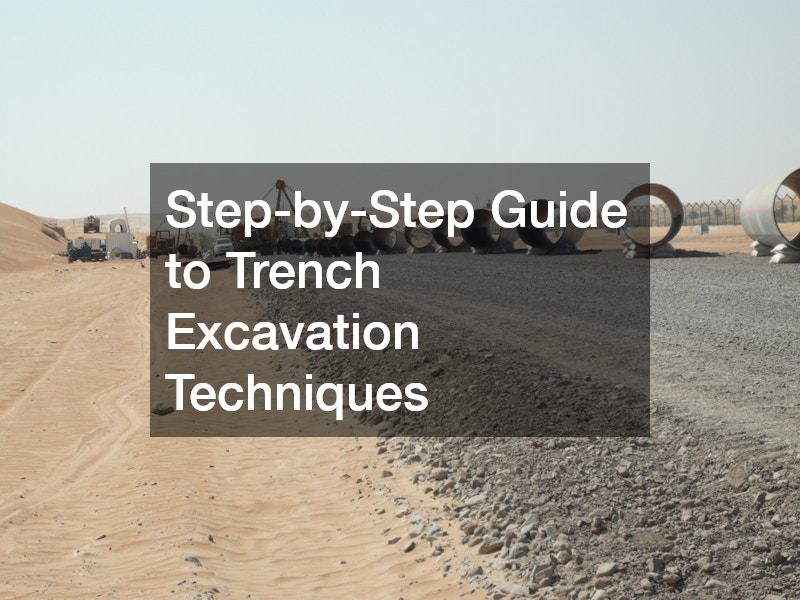Trench excavation plays a crucial role in construction and infrastructure development across Australia. Whether it’s laying underground utilities, installing drainage systems or preparing footings for buildings, properly executed trenching ensures safety, efficiency and compliance with engineering standards.
However, the process involves more than just digging a hole—it requires careful planning, selection of suitable equipment, understanding soil conditions and adhering to safety protocols. This guide offers a comprehensive step-by-step breakdown of trench excavation techniques to help contractors, site supervisors and project managers ensure optimal results on-site.
Planning & Site Assessment
Before any physical digging can begin, the site must be thoroughly assessed. This involves reviewing engineering drawings, identifying the trench’s location, dimensions and depth and considering environmental impacts. Site surveys are essential for detecting underground utilities such as water pipes, gas lines and electrical cables. Dial Before You Dig services in Australia provide critical information to prevent utility damage and potential hazards. Assessing ground conditions is also necessary to determine soil type and stability, as these factors influence the excavation method and support systems required. A proper risk assessment ensures the planning phase includes contingencies for soil collapse, weather conditions and potential obstructions.
Setting Out the Trench
Once the planning is complete, setting out the trench begins. This process ensures the trench follows the designed path accurately. Surveyors mark the trench alignment using pegs, string lines or spray paint, establishing the excavation boundaries and depth indicators. It’s important to align these markings precisely to the project’s specifications to avoid costly mistakes later in the build. At this stage, the excavation team must ensure that all access routes for machinery are clear and that space around the trench allows for material stockpiling and worker movement without risk.
Choosing the Right Equipment
Equipment selection depends on the trench dimensions, site conditions and volume of earth to be removed. Common excavation tools include backhoes, trenchers and excavators fitted with trenching buckets. For deeper or narrow trenches, hydraulic trenchers offer precision and speed. In some residential or tight-access projects, smaller machines or even manual digging may be necessary. Choosing the right equipment not only boosts efficiency but also enhances safety, especially in built-up or unstable environments. Operators must be trained and certified and machinery maintained regularly to prevent mechanical failures during excavation.
Excavation Process
Trench excavation must proceed systematically. Operators begin by removing the topsoil and storing it separately for later reinstatement. Excavation continues in layers and regular checks ensure the trench remains aligned and to the correct depth. The spoil or excavated soil, should be placed at least one metre from the trench edge to prevent accidental collapse. For deeper excavations, staged digging helps maintain trench integrity. The sides of the trench must be stabilised or supported using shoring systems, particularly in sandy or loose soils prone to collapse. A combination of steel trench boxes, hydraulic supports and battering techniques may be used to achieve this.
Shoring & Trench Safety
Shoring systems are critical to maintaining trench safety. Australian Work Health and Safety (WHS) regulations mandate protective systems for trenches deeper than 1.5 metres. These can include trench shields, slide rail systems or benching techniques to support trench walls. In certain cases, where trench depth is shallow and soil is cohesive, benching alone may suffice. Regardless of the system, the focus must remain on preventing cave-ins and protecting workers inside the trench. Safety barriers, signage and restricted access around the excavation area are also required to keep non-essential personnel out and reduce on-site accidents.
Dewatering & Groundwater Management
Trench excavation often encounters groundwater, particularly in coastal or low-lying areas. Effective dewatering is essential to maintain a dry work environment and prevent trench wall collapse. Pumping systems, sump wells or well-point systems may be employed depending on groundwater volume and flow. Engineers may also apply geotextiles and drainage aggregates to manage water infiltration. Continuous monitoring during excavation helps to detect any changes in groundwater conditions that might impact trench stability or safety. Dewatering systems must be maintained to prevent equipment failure that could compromise the excavation.
Laying Services or Structural Elements
Once the trench is fully excavated and stable, the next step is to lay pipes, conduits or foundation elements. The trench bed must be levelled and compacted to provide a firm base. In the case of utilities, sand or gravel bedding may be placed before the installation of pipes to cushion and support them. Engineers must ensure that service levels and gradients meet design requirements, especially for drainage and sewerage systems. Proper alignment and joint sealing prevent future leaks or service failures. Final inspections should be carried out before any backfilling begins.
Backfilling & Compaction
Backfilling restores the trench to ground level and protects the newly installed services. This stage involves placing excavated soil back into the trench in controlled layers. Each layer must be compacted using appropriate equipment to avoid future ground settlement. Select fill materials, often finer or gravelly soils, may be required around delicate pipes to avoid damage. Proper compaction not only ensures structural stability but also prevents future surface depressions or trip hazards. Topsoil is replaced last to restore the area’s original appearance or support landscaping where required.
The Importance of Mastering Trench Excavation
Trench excavation is far more than just removing soil—it’s a complex, methodical process that underpins many essential infrastructure projects across the country. A successful excavation project hinges on thorough planning, the correct use of equipment and strict adherence to safety and engineering standards. From site assessment through to backfilling and compliance checks, each step in the trench excavation process plays a vital role in ensuring long-term project integrity and safety. By following best-practice techniques and Australian regulatory requirements, contractors can reduce project risks, increase efficiency and achieve quality outcomes that stand the test of time.
.





